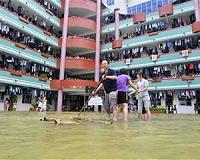| . |  |
. |
Manila (AFP) June 25, 2010 Hundreds of thousands of slum dwellers remain living in flood-prone areas of the Philippine capital as the rainy season builds despite pledges to move them after a barrage of deadly storms last year. A month into the tropical nation's annual rainy season, entire communities that were hit hard by the disasters that killed about 1,000 people are vigorously resisting government efforts to move them to safer places. At the Arenda estate, a 200-hectare (494-acre) swamp in eastern Manila, the holdouts prefer to park dugout boats on their yards, ready to jump in with their meagre belongings should the floods return. "The surroundings might be miserable, but we don't have to pay rent," Elvie Edaos, an unwed 52-year-old mother-of-four who barely earns a living by making dresses, told AFP. "We can eat swamp cabbage, we can gather clams for free, and we can collect driftwood with which to cook them." Linked by flimsy wooden footbridges, the crowded shanties on the shore of Laguna Lake are warrens of plywood and metal sheets sitting precariously on thin stilts above the garbage-flecked water hyacinth beds. Some sections lie below the lake's water level, and the government says the community, colonised by poor city migrants in the mid-1990s soon after the government turned the swamp into an open dump, is a double-barrelled problem. Not only are its residents at risk from future floods, their homes also prevent floodwaters from receding. President Gloria Arroyo declared the slum unfit for habitation and sent in demolition teams when last year's floodwaters finally receded, but 50,000 shanties housing nearly a quarter of a million people still stand months later. Mother-of-two Marites Lerion lives in constant fear of both the demolition crews and the slimy water lapping at her floorboards. "One time my son fell through the floor. He could have easily drowned," Lerion said. But her family cannot afford to flee because doing so would mean having her husband give up his job of driving a pedicab, which earns him 150 pesos (about three dollars) a day. Aside from killing 1,000 people, Tropical Storm Ketsana and Typhoon Parma severely affected 9.3 million others in Manila and areas to the north, according to a World Bank report that assessed rehabilitation costs. "Coupled with the likely impacts of climate change, the drainage system can be expected to be overwhelmed again within the lifetime of most victims," it said. The report urged Manila to consider larger investments, particularly in flood control and housing for informal settlers who bore the brunt of the calamities. Manila should consider building high-rises so flood victims would live closer to their jobs, instead of uprooting them wholesale, it said. Corazon Cruz, deputy planning chief of the Metropolitan Manila Development Authority, said the slums complicate the body's main jobs of managing traffic, controlling floods, and dealing with other disasters in the city of 12 million. Cruz said there were at least 2.7 million squatters in Manila, and the number was growing. The World Bank report indicated the problem was much worse, listing half of Manila's population as squatters. Of most concern are about half a million people living in dangerous areas such as underneath bridges, atop open sewers, swamps, riverbanks, and beside railroad tracks, according to Cruz. The rest squat on private or government lots. "They should not be there in the first place and there have been efforts to move them out, but they go back, or others take their place," Cruz told AFP. Evicting them should be the work of local governments, according to Cruz. But some local officials will not lift a finger because they treat the slums as a rich source of votes during elections, she said. "It's also a political problem, we're all familiar with that," Cruz said. The post-flood wrecking crews removed about 600 Arenda shanties, but most of the relocated families have filtered back in, said village elder Nestor Narciso. "The government should have more compassion for these people," said Narciso, a district councillor. "The jobs are in Manila, so most came back." The local government in the area agreed. Instead of helping relocate them, it is now building a dyke around the community in hopes of keeping the waters at bay, Narciso added.
Share This Article With Planet Earth
Related Links Bringing Order To A World Of Disasters When the Earth Quakes A world of storm and tempest
 More rains lash flood-hit south China
More rains lash flood-hit south ChinaBeijing (AFP) June 24, 2010 Heavy rains lashed south China Thursday as the government set up emergency response headquarters to combat floods and landslides that have killed over 200 people and forced millions to evacuate. The scale of the disaster prompted Chinese Premier Wen Jiabao to fly to hard-hit Jiangxi province to inspect rescue and relief operations - his second visit to a flood-hit area in one week, state ra ... read more |
|
| The content herein, unless otherwise known to be public domain, are Copyright 1995-2010 - SpaceDaily. AFP and UPI Wire Stories are copyright Agence France-Presse and United Press International. ESA Portal Reports are copyright European Space Agency. All NASA sourced material is public domain. Additional copyrights may apply in whole or part to other bona fide parties. Advertising does not imply endorsement,agreement or approval of any opinions, statements or information provided by SpaceDaily on any Web page published or hosted by SpaceDaily. Privacy Statement |